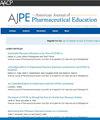Examining the Alignment of Pharmacists' Daily Tasks, Employer-advertised Skills, and the Entrustable Professional Activities
IF 3.8
4区 教育学
Q1 EDUCATION, SCIENTIFIC DISCIPLINES
引用次数: 0
Abstract
Objective
To understand alignment of pharmacist jobs’ daily tasks, employer-advertised skills, and pharmacy education of entrustable professional activities (EPAs).
Methods
The study team compiled the top 20 tasks pharmacists reported performing at least daily from the Occupational Information Network survey (2022), the top 50 employer-advertised skills from 89,819 pharmacist job postings in 2022 from Lightcast and the 13 EPAs from accreditation standards that define a practice-ready pharmacist. Two experienced faculty and licensed pharmacists mapped employer-advertised skills, each task performed at least daily, and the EPAs. Trends in alignment between what pharmacists report doing daily with these other stakeholder expectations were described.
Results
Of the top 20 daily pharmacist tasks from the Occupational Information Network, 55% were categorized as product-centric. Legal compliance (30%) and prescription review (25%) were the employer-advertised skills most frequently mapped to these daily tasks. EPA 13 (pharmacy administration and operations) was the EPA most frequently mapped to daily tasks (45%). EPA 8 (education of the patient and others on medications) was the second most frequently mapped EPA to 30% of daily tasks.
Conclusion
Prescription processing, legal compliance, and operational pharmacy management are the most essential daily functions of today’s pharmacists, contrasting with the person-centered nature of the EPAs. Amid the curricular evolution that has occurred to meet the future vision of pharmacy practice, programs must, nonetheless, continue to teach the skills required for the existing marketplace to ensure that graduates are practice-ready for today’s positions.
检查药剂师的日常任务,雇主宣传的技能和可信赖的专业活动的一致性。
目的:了解药师岗位日常任务、用人单位招聘技能与药学专业活动委托教育的一致性。方法:研究小组汇编了职业信息网络调查(2022年)中药剂师报告的每天至少执行的前20项任务,Lightcast在2022年发布的89,819个药剂师职位中雇主宣传的前50项技能,以及定义实践就绪药剂师的认证标准中的13项EPAs。两位经验丰富的教师和有执照的药剂师绘制了雇主宣传的技能,每项任务至少每天执行,以及epa。趋势对齐药剂师报告每天做这些其他利益相关者的期望进行了描述。结果:在职业信息网络的前20名药剂师日常任务中,55%被归类为以产品为中心。法律合规(30%)和处方审查(25%)是雇主宣传的技能,最常与这些日常任务相关联。EPA 13(药房管理和操作)是EPA最常映射到日常任务(45%)。EPA 8(对患者及其他人进行药物教育)是第二常见的EPA,占日常任务的30%。结论:与epa以人为本的特点形成鲜明对比的是,处方处理、法律合规和药学运营管理是当今药师最基本的日常职能。在满足未来药学实践愿景的课程演变中,尽管如此,课程必须继续教授现有市场所需的技能,以确保毕业生为今天的职位做好实践准备。
本文章由计算机程序翻译,如有差异,请以英文原文为准。
求助全文
约1分钟内获得全文
求助全文
来源期刊
CiteScore
4.30
自引率
15.20%
发文量
114
期刊介绍:
The Journal accepts unsolicited manuscripts that have not been published and are not under consideration for publication elsewhere. The Journal only considers material related to pharmaceutical education for publication. Authors must prepare manuscripts to conform to the Journal style (Author Instructions). All manuscripts are subject to peer review and approval by the editor prior to acceptance for publication. Reviewers are assigned by the editor with the advice of the editorial board as needed. Manuscripts are submitted and processed online (Submit a Manuscript) using Editorial Manager, an online manuscript tracking system that facilitates communication between the editorial office, editor, associate editors, reviewers, and authors.
After a manuscript is accepted, it is scheduled for publication in an upcoming issue of the Journal. All manuscripts are formatted and copyedited, and returned to the author for review and approval of the changes. Approximately 2 weeks prior to publication, the author receives an electronic proof of the article for final review and approval. Authors are not assessed page charges for publication.

 求助内容:
求助内容: 应助结果提醒方式:
应助结果提醒方式:


